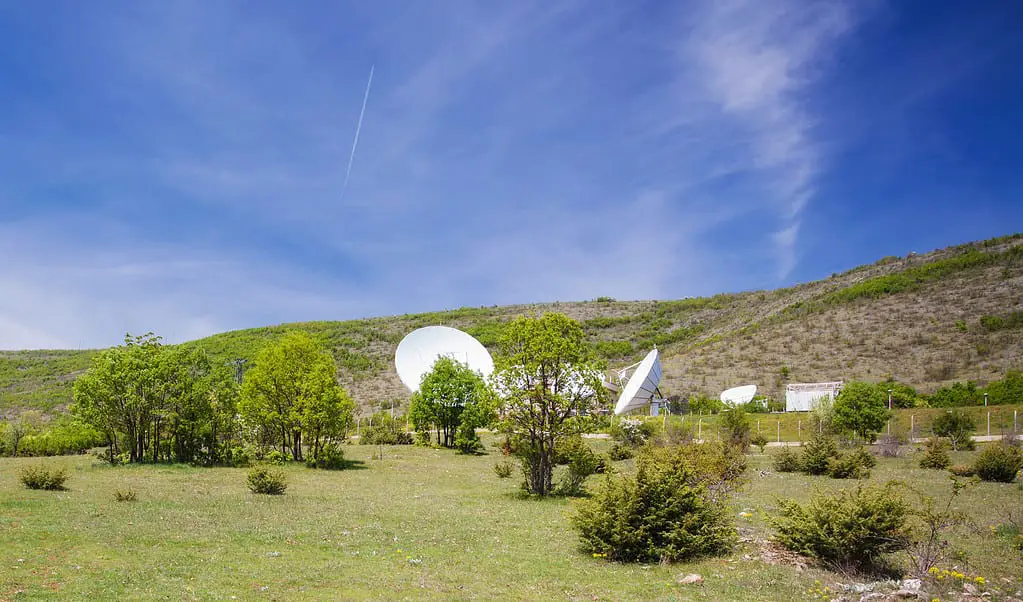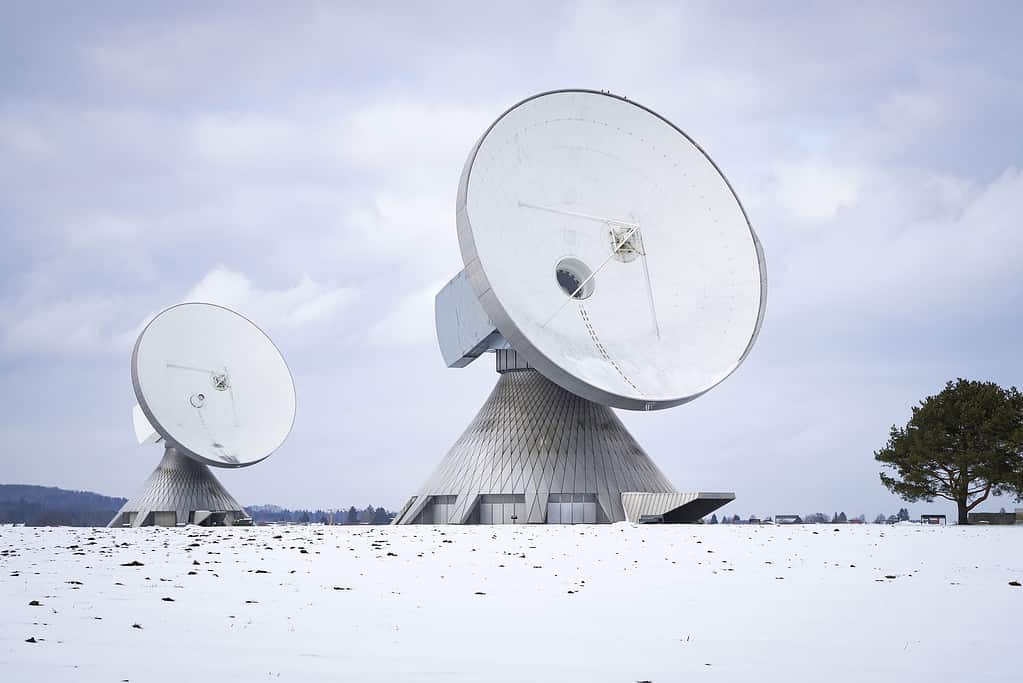How Will Starlink Work in Bad Weather? When SpaceX launched Starlink, it was introduced as a high-speed, low-latency internet service that serves everyone, especially in areas with poor internet connectivity.
Its key selling point is its ability to maintain its high-speed, low latency ability even in bad weather conditions, unlike other satellite internet services. But exactly how will Starlink work in bad weather?
We will look at how it does in every lousy weather.
Table of Contents
- How does Satellite Internet Work?
- How Bad Weather Can Affect Starlink
- Does Temperature Affect Starlink?
- How to Minimize the Effect of Bad Weather on Starlink?
- Starlink Must-Dos in Bad Weather—Backups
- Conclusion
How does Satellite Internet Work?
Satellite internet begins when an internet service provider sets up satellites in space. The internet users receive the signal in a receiver dish from the ISP through those satellites.
Usually, the receiver dish is placed in your home somewhere outside where it can receive the signal unobstructed (in most cases, the roof). Finally, the user connects a modem/router to the receiver dish to get internet inside the house.
All this movement of signal happens over the air, meaning any obstruction from buildings or bad weather can affect your connectivity.
But unlike other satellite internet providers who have their satellites in geosynchronous orbit, Starlink operates theirs at a much lower altitude, or in other words, in low earth orbit.
This means their signal travels a far less distance, which is why it’s rarely interrupted like others.
How Bad Weather Can Affect Starlink
Nonetheless, Starlink internet is not entirely immune to bad weather conditions. While the design and construction of its receiver dish are very advanced, adverse weather can still cause some issues.
Let’s look at how Starlink’s internet behaves in different weather conditions.
1. Clouds
Typical clouds, even when the day is very cloudy, do not affect Starlink’s internet in any way. This is because the Starlink satellites are very close to us, so minor obstructions like clouds do not affect the signal.
This can change, however, if the clouds have a lot of moisture just before rain falls.
The density of rain clouds is heavy enough to cause signal obstruction sometimes, causing lower internet speed and delays.
Rarely do clouds cause an internet outage until it rains heavily.

Satellite dish
2. Wind
Again, even the strongest wind cannot affect the Starlink signal because it’s traveling a very short distance. Strong winds only affect your internet if it blows your receiver dish or antenna out of position.
The receiver dish is usually positioned to communicate directly with the satellites. If the wind moves your dish in a different direction, contact is bound to break.
You can prevent this by installing the dish where it’s protected from strong winds. For example, place it on the roof under an eave and use additional support and mounting hardware to secure it firmly.
3. Rain
Mild rain generally does not affect Starlink’s internet. It is heavy downpours and storms that you need to worry about. Heavy rains start with dense clouds and equally dense water falling.
These two are enough to cause an obstruction of signal for the period the rain lasts.
According to a Starlink Outages Report, during a particularly heavy storm, outages are common during bad weather in low-capacity areas. But as the rain becomes light, the signal will also stabilize.
Interestingly, heavy rains affect the signal even if it’s not raining where you are. If the rain (wherever it is) obstructs your dish and the satellite or the ISP and the satellite, there will be internet outages or delays.
The other question about rain and Starlink internet is, does the dish get wet?
No. Starlink receiver dishes, routers, and cables are waterproof, so wetness will not affect them.

Two internet satellite dishes in snow
4. Snow
Once again, light, fluffy snowfall will not affect the Starlink signal. What you should worry about is heavy snow because of the density of water in the air. The moisture content in the snow is what matters, not the amount of snow.
That’s because the density will obstruct the signal from passing through.
Thankfully, Starlink receiver dishes have a heating function that detects snow and melts it automatically. This prevents snow from building up on the antenna and obstructs the signal.
But when the snowfall is heavy, consider manually wiping the ice off the dish.
5. Fog
Fog is moisture in the air, so the denser it is, the worse your internet will do. Regular fog events rarely cause internet issues but heavy fog will. In many cases, heavy fog will only cause a slow connection but not a complete outage.
6. Lightning
Lightning is often an issue for Satellite internet because of the dish location. We mostly mount our receiver dish at the top of the roof or on a pole higher than your roof, making them easy targets for lightning.
Several Starlink users have reported their dishes and adapters being burned to coal by lightning.
But that’s not the worst part. If lightning strikes your dish, everything connected to it, including your electronics in the house, will also be damaged.
The solution is to run a ground wire from the dish to guide electricity from the lightning to the ground safely.
You should also install a surge protector in the house to protect electronics. A good electrician will help with all these.

Circular antenna
Does Temperature Affect Starlink?
SpaceX has three Starlink dishes, and each type reacts to temperatures differently.
- First-generation circular antenna.
First-generation antennae do not do well in extreme temperatures. It works best if the outside temperature is 32°F (0°C) to 86°F (30°C).
- Second-generation rectangular antenna.
This type has a better rating and can handle an operating temperature of -22°F (-30°C) to 104°F (40°C).
- Business antenna.
The business antenna is the best of the three and the biggest. It provides the fastest internet and has an IP56 rating for water and dust resistance.
According to SpaceX, this dish is tested to perform between temperatures of -22°F (-30°C) to 122°F (50°C).
However, users have tested the Starlink business antenna at -50F, and it worked perfectly.
It seemed to struggle more in extremely hot weather above 120F, especially if it’s mounted too close to the roof or ground.

Computer wif signal
How to Minimize the Effect of Bad Weather on Starlink?
While you can do little to protect your internet during heavy rains, storms, and high winds, these few precautions can minimize the effects.
Ensure the dish is pointing North.
High winds and heavy rainfall can disorient the dish and point it in other directions away from the satellites.
You may not notice it physically, but a technician will when they check the signal. Get the technician to stow the dish, power cycle it, and unstow it, so it’s facing north.
Clean the dish
Snow, leaves, and debris can physically cover the antenna and obstruct communication between the dish and the satellites.
Keep the snowmelt feature on during winter and clean the dish regularly to remove debris. In case of weighty snowfall, get up there and swipe the snow off your dish.
Ensure your dish is obstruction-free
Unfortunately, bad weather is not the only thing that can obstruct an internet signal.
The signal can have trouble passing through if you live in a heavily wooded area or a place with many high-rise buildings. You will notice this more during bad weather because two things are causing an obstruction.
To prevent this, get your Starlink dish at the top of a tall tree or tower in your home.
You can raise the height of your chimney or add a pole to boost the dish more. Ensure it’s well mounted, secured, and earthed to protect it from high winds and lightning.

Satellite on top of a tower
How Will Starlink Work in Bad Weather: Use a protective cover
A satellite dish cover protects the dish from getting covered in snow, ice, and debris, even if it’s not plugged in. Ice and snow buildup can cause damage to the dish after a while or block the Starlink signal.
Find the right cover at Lone Pine because every Starlink dish has a different shape and size.
How Will Starlink Work in Bad Weather: Use grounding or lightning protection measures
A lightning protection system is the only way to protect a receiver dish from getting toasted by lightning.
This system includes a ground rod that will send the electric surge from lightning to the ground instead of your electronics, a surge protector for your house, and a lightning rod.
Starlink Must-Dos in Bad Weather—Backups
It’s generally safe to use Starlink internet during bad weather. The entire package is designed to withstand bad weather without damage to the hardware or connectivity issues.
But on the rare occasion when you face an internet outage due to bad weather, you should have a backup in mind.
Cellular 5G home internet is a great backup option for areas with stable cell service. 4G LTE from a reliable provider like Verizon also works great.
These wireless internet options rely on the closest cell tower, so bad weather does not affect them since the signal travels a very short distance.
Conclusion
How will Starlink work in bad weather?
Outstandingly. No other satellite service can withstand bad weather conditions like Starlink.
You may notice a light change in speed if you are streaming or playing games, but internet outages are rare with this service.

